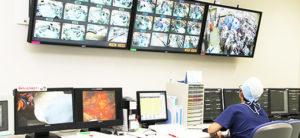History
Göttingen is a university city in Lower Saxony, north-central Germany, with a population about 120,000. The university was founded in 1737 by George II (George Augustus; 1683-1760, reigned 1727-1760), Elector of Hanover, with four faculties: philosophy, theology, law, and medicine. Today, it is one of Germany’s leading universities with approximately 28,000 students in 13 faculties and is officially known as the Georg-August-Universität Göttingen, named after its founder.
The first notable figure in the history of the Göttingen Medical School is Albrecht von Haller (1708–1777), a founding professor of anatomy, surgery, and botany. He was born in Switzerland and studied in the Leiden University under Herman Boerhaave (1668–1738) of European fame. He taught at Göttingen from 1736 to 1753 and published “Primae lineae physiologiae” (1747) to pioneer the genre of physiology and “De partibus corporis humani sensilibus et irritabilibus” (1752) which paved the way to the studies of experimental physiology in the 19th century. After retiring from the university in 1753, he compiled in his hometown of Bern bibliographic works to comprehend medical treatises from the ancient to his time, including “Elementa physiologiae corporis humani” 8 volumes (1757–1766), “Bibliotheca botanica” 2 volumes (1771–1772), “Bibliotheca chirurgica” 2 volumes (1774–1775), “Bibliotheca anatomica” 2 volumes (1774–1775), and “Bibliotheca medicinae practicae” 4 volumes (1776–1788). The medical collection of the University of Göttingen was utilized as an important source in these works.
Another notable figure was Johann Friedrich Blumenbach (1752–1840), who served as the professor of medicine from 1778 until his death. In his dissertation “De generis humani varietate native” (1775), he distinguished races according to physical characteristics and is considered the founder of physical anthropology. He published “Handbuch der Naturgeschichte” in two volumes (1779–1780) becoming a bestseller textbook in the natural history, and advocated the principle of the Bildungstrieb (1780) based on vitalism influencing greatly on the biological thought in the next era.
Since its establishment, the Göttingen University Library was proud of its independence from religious censorship and its well organized and systematically categorized collection, and was considered one of the leading libraries in Germany. The great polymath and writer, Johann Wolfgang von Goethe (1749–1832), visited the library in 1801 and called it "capital which silently generates incalculable interest".
The more than 2,500 classic medical books from the Göttingen University Library were doomed to come to Japan due to the plan by the university to dispose of a part of its collection to secure financial resources during the Great Depression after World War I. Gito Teruoka of Kurashiki Institute for Science of Labour studying in Germany at that time evaluated highly this collection and consulted Magosaburo Ohara, President of Kurabo Industries LTD who favored and assisted him financially to purchase the collection. In 1971, the Institute moved to Kawasaki and built a library to house the collection. In 1977, the “Catalog of the Göttingen Medical Classics Collection” was published. In 1999, the Kurashiki Central Hospital celebrated the 75th anniversary and received a transfer of the collection from the Institute.
The current collection catalog (electronic as of November 28, 2023) contains 2,566 books. Of these books, two were published in the 15th century, 32 in the first half of the 16th century, 143 in the second half of the 16th century, 204 in the first half of the 17th century, 435 in the second half of the 17th century, 509 in the first half of the 18th century, 1044 in the second half of the 18th century, and 155 in the first half of the 19th century, and the remaining 42 were of the unknown published date. Among the most valuable is William Harvey's “Exercitatio Anatomica de Motu Cordis et Sanguinis in Animalibus” (1628), an extremely rare book remaining only about 50 copies in the world and of greatest importance in the history of medicine. The collection includes Dioscorides’ “De materia medica” (1518) and Celsus’ “De medicina” (1528) from ancient Rome, and in addition Avicenna’s “Canon Medicinae” (1564), Vesalius’ “De humani corporis fabrica” 2nd edition (1555), Bidloo’s “Anatomia humani corporis” (1685), Albinus’ “Tabulae sceleti et musculorum corporis humani” (1747), and many other beautifully illustrated anatomy books, making it a bibliographic treasury of the traditional Western medicine with inestimable value.
Adviser
 Professor Tatsuo Sakai, MD, PhD
Professor Tatsuo Sakai, MD, PhD
Faculty of Health Science, Juntendo University, and Vice President of the Japanese Society for the History of Medicine
Graduated from Faculty of Medicine, University of Tokyo in 1978. Assistant professor at Faculty of Medicine, University of Tokyo since 1978, study abroad at University of Heidelberg (1984–1986), associate professor at Faculty of Medicine, University of Tokyo since 1986, professor at Department of Anatomy and Life Structure, Faculty of Medicine, Juntendo University since 1990, and specially appointed professor at the present office since 2019, concurrently at Department of Anatomy and Life Structure and Department of Medical History. Appointed as the 12th President of the Japanese Society for the History of Medicine in 2017 and has served as Vice President since 2023.







